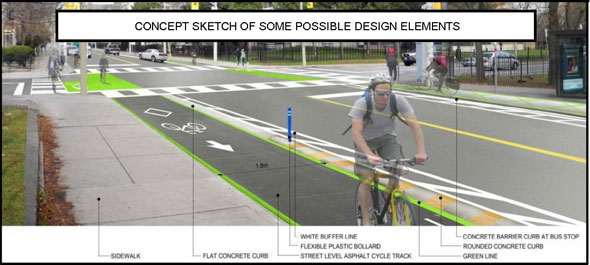
How should the city separate its new bike lanes?
Toronto's first fully separated bike lane arrived on Sherbourne Street this fall, for the first time giving bikers the opportunity to move north and south through the eastern portion of downtown without mixing with traffic. But despite a rolled curb segregating autos and bikes, there have been numerous instances of cars using the narrow lane for on-street parking.
The curb was designed to allow emergency responders, TTC Wheel-Trans, garbage trucks, and snow removal vehicles to pass over the top while acting as a barrier to everyday traffic. Unfortunately, by making it easier for those that need to reach the curb, the city has also made it easy for drivers to illegally block bike traffic.

At last month's city council meeting, a similar separated cycle lane for Wellesley and Hoskin was given the green light. According to David Dunn from the city's Cycling Infrastructure and Programs department, a temporary rubber curb will be bolted to Wellesley east of Yonge in 2013. Between then and 2014 the same system of raised and separated lanes will gradually be installed between Parliament and St. George streets, the entirety of the bike track.
"For the section that will be reconstructed in 2014, both a street level or raised cycle track design will be investigated. Sherbourne provides examples of both of these types of permanent cycle track designs - "raised" from Gerrard to King and "street level" rolled curb design from Gerrard to Bloor," Dunn says in en email.
The exact look hasn't been finalized yet, but it's likely to match what's already in place on Sherbourne and under construction on Queens Quay at the expense of all on-street parking and left turn lanes.
Cities like Vancouver and Montreal separate traffic in a much more dramatic way, using concrete planters or high curbs in some cases, making it much harder for confused delivery truck drivers and motorists to blunder onto the bike track.
Given that the city has a chance to learn from the problems on Sherbourne Street should it too look at alternative ways of marking the edge of the bike lane, or should we spend that money educating drivers and ticketing those that break the rules? Is our current method the best since it allows access to the curb to those who need it?
Chris Bateman is a staff writer at blogTO. Follow him on Twitter at @chrisbateman.
Photo: "New Sherbourne Separated Bike Lane" by Martinho from the blogTO Flickr pool.
Latest Videos
Latest Videos
Join the conversation Load comments







